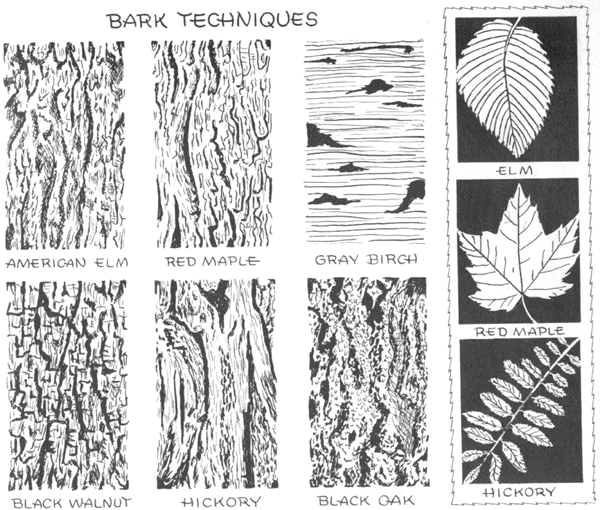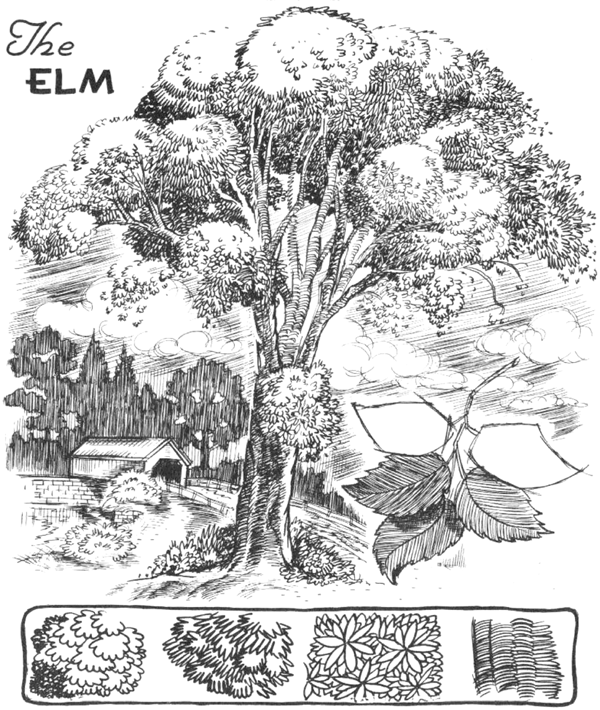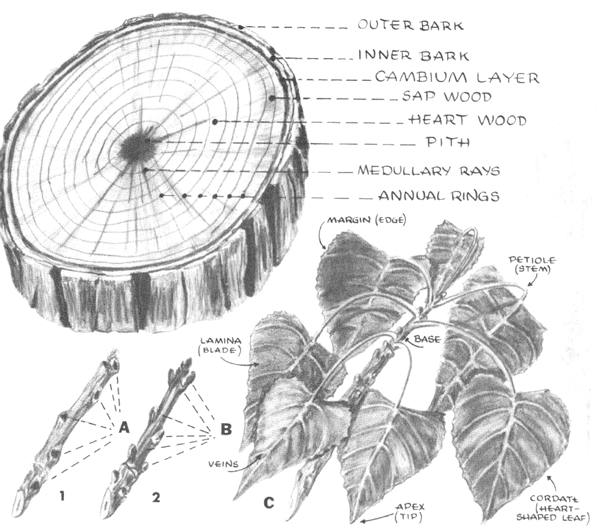Page : 1 2
Illustrated above are a series of rather detailed renderings of various bark textures. These drawings were included to encourage you to make close-up studies of tree barks. Such studies can be done in any sort of media, such as pencil, charcoal, watercolors, oils, pastels, acrylics, etc. It really doesn’t matter as long as you start to understand the differences in the types of barks and textures. Likewise, individual sketches of leaves should he made, to help one become familiar with the character of trees. The study of tree anatomy is very helpful toward the ultimate execution of convincing landscapes. It is great to keep a drawing journal to draw different things that you see during the day…and if you do this you will learn how to draw a lot quicker. This is also very helpful for drawing different types of trees, barks, leaves, foliage, landscapes, etc.
TREES (RENDERING TECHNIQUES) :
Obviously when executing a tree, we do not try to render every leaf. Foliage should he suggested in relationship to its direction of growth and in a technique which seems best to us to interpret its character and texture. Observe that the elm has a shape similar to that of an umbrella. To construct it, first draw the skeleton. Proceed then to block in the general shapes of the various foliage masses. Foliage should be executed in scalloped, irregular lines as illustrated in the lower panel. These wavy lines should pivot at different directions. The light strokes of the foliage were executed originally with a crow-quill pen. A Gillott’s No. 170 pen was used for the heavy or shadow strokes.
The technique of the background in the illustration has been handled lighter in value than that of the foreground. Such procedure gives depth to our pictures and is an example of aerial perspective. This is not to be confused with linear or circular perspective, which was studied in our first chapter on Basic Art. Note that the bark texture of the tree was not handled realistically. However, it represents an interesting technique for use in pen-and-ink work.
There are many techniques in the handling of trees. These will vary depending upon the character of the tree, the media used. and the artist’s individual style. The above illustration was originally drawn twice the size that you see it reproduced here, on smooth (plate finish) Strathmore illustration board. The tree was first sketched and then inked with a crow-quill, Gillott’s No. 170 pen, and a No. 1 red sable brush.
The weeping or Babylon willow is marked by its slender and delicate leaves. its upright trunk and long, drooping, graceful branches. It is one of the most universally painted of all trees, and has been a favorite for artists since early times. Since the period of the Psalmist and during the time of Napoleon, the tree has been linked with instances of grief. From these associations. it has received its name–the weeping willow.
However, the important factors to remember in the execution of a tree are—to repeat—character, texture, and lighting. Technique and medium are purely personal matters, relative to the artist’s preference.
[ad#draw]
DENDROLOGY
This is a technical term which literally means ” the study of trees.” The line of demarcation between a tree and a shrub is at times difficult to define. However, a tree is usually thought of as being at least twenty feet or more in height, at maturity having a single trunk. and its branches starting not less than several feet from the ground. Conversely, shrubs are shorter. have low spreading stems, and are bushy in appearance. The serious painter of landscapes should acquaint himself with tree
habits, geographical distribution of different species. Etc.
Illustrated above is a transverse section of a mature tree trunk. There are basically two types of tree stems or trunks, the endogenous which infers that the wood is made up of separate fiber threads scattered throughout the whole diameter of the stem. Secondly, the exogenous stern, defined as wood which is collected as to form a layer surrounding a central column of pith and encompassed by bark.
In Fig. A is shown the leaf scars of a twig. These result from leaves which have fallen from a twig. In Fig. B are shown leaf buds. Buds are either scaly or naked. Fig. C illustrates an example of a simple leaf type. There are 16 common varieties of leaf shapes.
FOLIAGE, SHRUBBERY AND GRASS:
To draw a bush, first rough out its contour. Next determine its light source (in the bush illustrated above, the lighting is from the left). Then block out its tone values into simple planes. This procedure will enable you more easily to render the contour of the bush into values of lights and darks. Foliage is executed, relative to its lightness and darkness, within these planes. The techniques used in handling shrubbery are quite similar to those of tree foliage.
In pen-and-ink technique, grass is usually suggested by short, verticle strokes of varying lengths. In more modern art, we often see grass texture suggested by means of short, horizontal strokes. When grass is long and weedy, it should be expressed with action, by strokes at varying angles.
Illustrated at the right is a watercolor executed on a vellum finish, 2-ply Strathmore paper. The technique is loosely handled and was executed with ivory black, thinned with water. A piece of art rendered in tones of grays. is termed a wash drawing.
Concluding this section on trees, foliage, etc., I should add that seasons and weather conditions, of course, will greatly affect your subjects. Trees in a windstorm or rendered with snow on them, become very challenging subjects.
Technorati Tags: drawing trees, how to draw trees, tree drawing tutorial, tree drawing lessons, how to draw bushes, how to draw leaves, leaves, leaf, trees, bushes, foliage, bark, twigs, branches, drawing lessons, drawing tutorials, nature, drawing nature
Page : 1 2
Pages: 1 2





beautiful. thank you for sharing!
THANK U, PLEASE SEND MORE BASICS FOR DRAWING, LEARNERS STAGE
i really liked the old cartoon-y “how-to” look of the images. Very period-authentic. Were they by the author or from an old book (and if so which one)?
This helped me SOO much on my drawing.
Awesome thanks for the tips
really cool!!!!